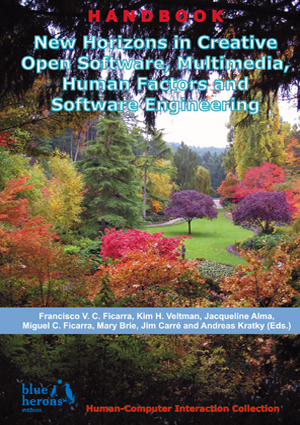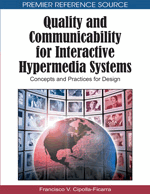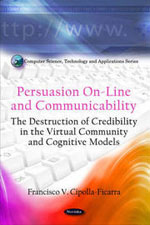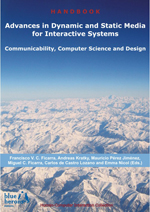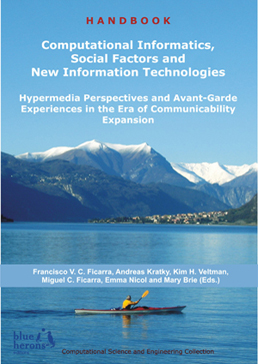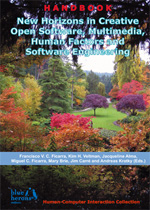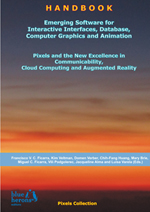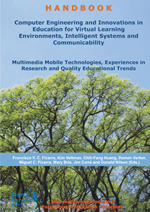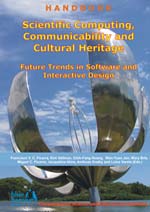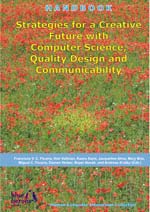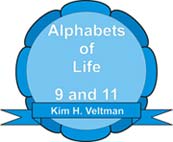New Horizons in Creative Open Software, Multimedia, Human Factors and Software Engineering
:: Human-Computer Interaction Collection ::
:: Revised Selected Chapters ::
Main Editor: Francisco V. C. Ficarra
Co-editors: Kim H. Veltman (Maastricht, The Netherlands), Jacqueline Alma (Vancouver, Canada), Miguel C. Ficarra (Italy and Spain), Mary Brie (La Valletta, Malta), Jim Carré (Willemstad, Curaçao), and Andreas Kratky (Los Angeles, USA)
Editorial Assistant: Luisa Varela (Perpignan, France)
Book Details
• ISBN: 978-88-96471-01-2 :: DOI: 10.978.8896471/012
• Publisher: Blue Herons Editions
• Location: Italy (Bg)
• Subjects: HCI, Informatics, Computer Graphics, Open Software, Animation, Programming
• Subjects: Scrum, Biometric Authentication, Intelligent Agents, Entertainment, e-Learning
• Subjects: Communicability, e-Health, Identity Document, Pervasive Computing, Simulation
• Subjects: Human Factors, Education, Virtual Environments, System Security, 3D Model
• Subjects: Design Patterns, Heuristic Analysis, Parameter Sweep, Cloud Computing, ICT
• Subjects: Software Engineering, Discrete Sequence Analysis, Semiotics, Personalization
• Copyright: 2012
• Collection: Human-Computer Interaction
• Series volume: II
• Publication date: April, 2012
• Binding: Paperback
• Grade level: General
• Language: English
• Illustrations: Yes
• Colour: Yes
• Pages: 179
• Dimensions: 11.41x8.26x0.4 in. 1.29 lbs. :: 290x210x13 mm. 587 gr.
Preface
There’s perils enough along the way, and trials and sufferings sore; but danger never yet frightened me, and things are just what they’ve got to be; if we miss the way, there’s many a one has missed the way before –Martín Fierro.
José Hernández (1834 – 1886)
Since the genesis of the democratization of the computer hardware and software came about in 1980 the human being has been unwittingly the apex in which a series of changes in the daily life took place, regardless of his/her financial resources or the geographical place where they are.
Computer science starting from this decade would entail a series of changes which very few experts of the sector could forecast in an accurate way already at that time, except some literary genres, such as the example of science fiction literature. However, since the start of 1990, the breakthroughs in software engineering, computer science, systems, telecommunications, multimedia, etc. left as outdated even the predictions made in the context of literary imagination.
All of this in response to the phenomenon of democratization and free access to the static and dynamic contexts, through off-line and on-line interactive systems. A global event which gained room vertiginously in front of the so-called traditional social mass media.
However, the vision of the expansion of communication towards the communicability of interactive contents turns out to be near-sighted in some environments of software engineering, going so far as to attack the emerging sectors, especially those which were are related to the logical evolution of the social mass media first towards multimedia, then hypermedia, until reaching the current social networks.
The growing demand of the millions of users of content in hypertext, multimedia, hypermedia, virtual reality, mixed reality, videogames, etc. has led some of the main agents of the field of software and college computer science, instead of resorting to creative solutions in the college curricula to cover qualitatively and quickly the areas related to the human-computer interaction to be oriented to the simple mercantilist factor in the short term, sidelining or destroying a strategic sector of the societies of the new millennium. That is, educators and local college researchers who were not persuaded at the height of these historical circumstances and the challenge that all meant in the technological (r)evolution for the future generations.
Now the communities to which these agents belong are setting constantly new records of the unemployed in their active workforce. Here is a great paradox or contradiction of the software and the hardware of the new millennium where the human beings without a job live or survive in highly computerized communities marked by cities which thanks to Information and Communications Technology (ICT) cover practically 100% of the productive activities of goods and services.
The current handbook intends to be a modest vademecum to address the mistakes of the past, focusing on the new generations and the leaders who must guide them in the educational process. It is these members of the population pyramid who must glimpse the new horizons in the hardware and the software. Obviously without leaving aside the human aspects, since on these will depend the success or failure of the generation and distribution of goods and/or services at local and/or global level, both in the present and the immediate future.
In the conclusions and future lines of research in each one of the presented works interesting starting points to understand the current situation are formulated covering in many fields of software engineering and especially the developments which can be made with the open software, for instance. Without any doubt we are in a novel period of computer industry where the changes in the trends or fashions stemming from the social networks may affect the working orientation of millions of programmers, systems analysts, engineers, graduates, etc., with a salary or not, who collaborate in a selfless way in the development of certain online projects.
These projects boost the theoretical understanding of the common good of the citizens in the global village predicted by McLuhan. However, it is necessary to warn of the situations where the horizontality of the social networks sometimes ends up in setting the baits of the skilful members of these networks, that is, fishermen under disguise who get great profits from the work of a myriad anonymous collaborators in the national and international networks, with a cost equal to zero.
Some of the works that make up the current compendium have been presented orally by their authors in the following international workshop and conference in Córdoba (Huerta Grande), Argentina: HCITOCH 2011 –Second International Workshop on Human-Computer Interaction, Tourism and Cultural Heritage: Strategies for a Creative Future with Computer Science, Quality Design and Communicability, and ADNTIIC 2011 –Second International Conference on Advances in New Technologies, Interactive Interfaces and Communicability: Design, E-commerce, E-learning, E-health, E-tourism, Web 2.0 and Web 3.0
The innovation and originality of those proposals has been the reason for which the authors have been invited to enlarge their works submitting again the new versions to an assessment process of said works by the members of the scientific committee. Consequently, these are works that have gone satisfactorily through a double process of international selection. In the next section a short introductory presentation of the research works that make up the current compendium is given:
In a simple, comprehensive and masterful way the author of the prologue “Learning Habits versus Habits for Knowledge”, Kim H. Veltman, makes a series of main aspects apparent that ponder on the impact of the new technologies on daily life in the present and the immediate future. The text is marked by exceptional cultural exquisiteness. In this way the reader will find interesting and innovating points of view with regard to the environment of the ICTs, such as: Social Networks and Adaptive Interfaces, Learning Habits, Habits for Knowledge, Personal Choices vs. Personal Preferences and Character, Familiar and Unfamiliar, Censorship, Brain Computing, Quandaries, etc. In each of these sections the creative element of the proposal is present, which implicitly entails the constant research of human beings, in the use of last generation of technological devices in the era of communicability expansion. In few words, it is an excellent beacon in the context of the thoughts over the past, present and future of the users of interactive systems on-line and off-line.
The chapter developed by Padma Polash Paul and Marina Gavrilova, presented under the title “Multifold Random Projection for Cancellable Face Biometric”, makes the importance of a new cancellable biometric template generation algorithm using random projection and transformation based feature extraction and selection apparent. It is a scientific research project where the issue of the biometric authentication systems is approached, which automatically identify or verify a person using physical, biological and behavioural characteristics such as face, iris, fingerprints, hand geometry or voice. Without any doubt a very timely study in the framework of safety of digital information. Among the findings of this study employing a series of examples, coupled with a wide bibliography, the results that satisfy cancellable properties of the biometric system are standing out above all. Simultaneously, they prove that the proposed system works very well on multi-view facial databases. The experiments have been very comprehensive and wide, since the authors have examined the proposal from several points of view to reach a novel conclusion in the context of biometric safety, resorting to several environments of graphic computing, databases, mathematics and others.
“Animation for Supporting Parent-and-Child Communication” is the research work presented by Kaoru Sumi and Mizue Nagata. In this chapter the effects of animation on the communication between children and adults are evaluated. A series of experiments have been developed along the research work to make the advantages and disadvantages of animations with dialogues apparent, among other goals. This is achieved though the use of “interactive e-hon“, an automatic word translation medium that provides expression through the use of 3D animation and dialog explanation to help users understand Web content or any other electronic resources. The examples incorporated by the authors in the text detail and explain very well the activities developed among children and adults in their use of interactive technologies. Besides, in this work apparent the importance for children and adults to count on a system of animation and dialogue which transforms the text in an automatic way is made. Finally, in the conclusions stipulate that there are several very interesting lines of research to increase the quality of communication among children, adults, and the interactive contents in the dynamic means of the current multimedia systems.
Guillermo Rodríguez, Alvaro Soria and Marcelo Campo are the authors of the chapter “A Virtual World to Educate Software Engineering Students”. They present an avant-garde virtual environment for the teaching of software engineering. The work displays how e-learning acquires a high level resorting to techniques and methods of three-dimensional graphic computing. The system developed called virtual xx makes apparent that the creativity and the efficiency in the programming of applications aimed at education do not require great financial budgets. The current work is an excellent example since it doesn’t only combine the educational knowledge, computer graphics, systems and usability engineering, etc., but is a real landmark in high quality equation in software and at a low cost. The examples which go with the text give an added value to illustrate the correct explanation of the developed project. Finally, the current proposal of research is complemented with the results of experiments made among professors and students in the use of the novel interactive system.
The research work “Describing Grid Services with FOSD” has been made by the following authors Natalia Trejo, Karim Hallar, and Sandra Casas. In this chapter a series of techniques, such as distributed computing, future-oriented software development as new software engineering, paradigm, service-oriented architecture, and software design methods converge. That is, a heterogeneous set of elements tending to present a field of the so-called ‘Emerging Technologies: Grid computing and Feature-oriented Development Software’. The authors use a clear and simple language to introduce their findings in an exemplary and progressive way along the text. The concepts they use are very well defined in the first section of the text. Later on the works about Grid services composition and its QoS (Quality of Service) characteristics, FOSD (Feature Oriented Software Development), approach and its application in Web services are described. In the third section the model to represent and specify Grid service using FOSD approach and DbC (Design by Contract) to include functional and non-functional requirements is described. Besides, an XML-based language –it to extend WSDL (Web Services Description Language) specification of Grid service is presented. In each one of these sections the illustrations encourage reading. The conclusions are a series of future lines of research, which allow to open new fields of research for all those interested in the issues.
Included in the context of software engineering, the authors Juan Francisco Silva Logroño, Luis Berdún, Marcelo Armentano, Analia Amandi present their work “Recognition of Software Design Patterns from the Interaction of a User with a CASE Tool”. It shows three central axis of research carried out by the authors: design patterns, discrete sequence analysis, and personal assistants. The content of the proposal is very well organized and expresses the main aspects consisting of creating a model from the sequences of actions that an export designer is expected to perform to model a design pattern in a CASE (Computer Aided Software Engineering) tool. This model is then used to detect possible design patterns a novice user might be trying to create in the CASE tool in order to provide him/her assistance in this task. The development of the main and secondary goals of the text are coupled with congruent examples, which support the reading of the proposal including a set of experiments, results, conclusions, and future lines of action in research. Finally, the bibliographical references have been selected in a correct way by the authors which also serve to deepen the current issues, if the reader is interested in it.
“Italian Electronic Health Record: A Proposal of a Federated Authentication and Authorization Infrastructure” is the title of the work presented by M. Claudia Buzzi, Francesco Donini, Abraham Gebrehiwot, Alessio Lunardelli, Cristian Lucchesi, and Paolo Mori. In this work, the authors describe a systematic collection of electronic health information about patients that can improve health care and personal safety through more accurate evidence-based decision support: Electronic Health Record (EHR). In a didactic way the authors put forward the motivations of the proposal. Besides, more main aspects of the research will be revealed, which can be summed up in the following way: the interoperability framework of the Italian Public Connectivity System (SPC) and the proposal for the interoperability framework for Electronic Health Record (EHR) systems developed in the OpenInFSE1 project. In this sense, the authors introduce a discussion on federated identity management and security aspects and issues, and the solutions for the management of the security policy.
The authors Rosanna Costaguta, Silvia Schiaffino, and Rubén Fares describe in their chapter “Fostering Team-role Balance in Computer Supported Collaborative Learning” the main aspects of a multi-agent model. This model monitors students participation in a group, recognizes their team roles as they work collaboratively, diagnoses the state of the collaboration considering balance of team roles as an ideal situation, and then proposes corrective actions when the group behavior is far from this ideal. In other words, there is a constant and perfect interrelation with computer supported collaborative learning (CSCL), team roles, team role balance, intelligent agents, and collaboration profiles. Others aspects of the study will be revealed, which can be grouped in the following way: the main concepts in the CSCL area, the advantages of its use in e-Learning. the concept of team role –describes different team role models, and focusing mainly on Belbin's model, the multi-agent proposal, and the Bayesians networks. Additionally, the related works and conclusions.
In the chapter “Realistic Nature Simulation as a Popular Entertainment Topic”, its author, Andreas Kratky, presents in the first instance a rethoric question: Which role does this displacement of our experience between reality and virtuality play for the individual as well as for the society? The focus of this work will be on the replacement of real nature experience with a technologically mediated experience of nature. In order to contextualize these observations he will gives a short historical overview over the genealogy of mediated experience of nature, which is indeed not a completely new phenomenon that only started with electronic media, but it has a long standing historical tradition. From this larger perspective he will includes a speculative outlook on possible developments and sketch several areas for future research. The illustrations that accompany the text allow to have a more detailed view of the state of the art, developed step by step by the author.
In the research work called “Cloud Computing for Parameter Sweep Experiments” the authors Elina Pacini, Melisa Ribero, Cristian Mateos, Anibal Mirasso, and Carlos García Garino present in an orderly, progressive way and with an excellent didactic level an empirical study on the employment of Cloud infrastructures to run parameter sweep experiments (PSEs) particularly in studies of viscoplastic solids together with simulations by using the CloudSim toolkit. This is a work where three-dimensional simulation such as the analysis of the finite elements is present. The content of the text starts with a study of the state of the art and the motivations of the current research work. Then the use of Cloudsim is explained which has been used in the experimental stage. The obtained results have allowed the researchers to establish in an interesting way not only the conclusions but also the multilayered and wide set of the future lines of research. The figures are comparative data and tables with the reached results, which will considerably facilitate the quick understanding of the current work.
The authors Rosanna Costaguta and Elena Durán propose in their chapter “Agents to Manage Student and Group Models in Systems” an important study to investigate the Computer Supported Collaborative Learning (CSCL) systems. They demonstrate that using these systems does not guarantee an effective collaborative learning. In other words, the uccess or failure of the learning experience depends on the collaborative skills the students show in the group. The authors show us each one of the aspects considered for a briefly theoretical framework, for instance, an introduction to personalization and user modeling in education, and an introduction to collaborative learning. Besides, a multi-agent model applied to CSCL environment is introduced. It aims both at recognizing conflicts occurring in group dynamics and also at providing personalized training of collaborative skills demonstrated by group members.
In the proposal called “Unified National Registry” the authors Mario Alberto Fidelibus, Eduardo Rolando Caturegli, and Eduardo Carlos Ferroni make apparent the importance of computer science to unify the data inside the borders of the Argentina state, avoid redundancies, and increase the safety of the information. The authors make a proposal to unify the information criteria about the proposals in a federate database. In the chapter can be seen a complete state of the art, with a diachronic vision to analyze the positive and negative aspects which motivate the current work. Also a complete description of the electronic Identity Card (ID) for the citizens is presented, tending to reduce the ambiguity and redundancy of citizen information in the public administration. Lastly the impact of information and data unification among the institutions and the citizens is made known with the current proposal.
In the chapter, “New Technologies and South European Universitary Education: The Dangerousness of the Human and Social Factors” its author presents one of the most important deviations between universitary education and potential users of interactive systems (NEETs generation –not in education, employment or training). These deviations have had a negative significance for the social sciences and computer science, for instance. The study focuses on the university academic field (Catalonia –Spain and Lombardia –Italy) from the 90s to the current time. A wide range of examples allows to confront quickly the consequences of these deviations in education, employment in Spain and Italy, and the future of the ICT (Information and Communication Technology) of Southern Europe. Finally, the author present a set of the educational quality criteria: CRUE – Compass Rose for University Education.
Francisco V. C. Ficarra
La Valletta, Malta (April 2012)
Partial Content On-line (pdf format)
• Front Cover (here)
• Preface :: Acknowledgment (here)
• Chapters :: Final Remarks :: Author Index :: Keywords Index :: References ... (here)
• Back Cover (here)
Additonal Handook Info
• Only paper copy – no digital book on-line and/or off-line –
• Special Price € 95 (expedition cost not included) ... e-Commerce :: Info Form
Welcome to Blue Herons Editions!
The origin of this publishing project is to be found in the Canadian lands, where nature presents itself generous in many places of its wide geography. More...
Education, Communicability, Design, Computer Science, HCI, Computer Graphics and Computer Animation:
We focus on education and new technologies with 32 years long experience. More...
Literature and Journalism:
Intersection between universal literature, local new journalism (true stories), sociology and legal immunity. Two collections:
- Casoncelli Bergamaschi
It is a typical bergamasque dough filled with meat, similar to the raviolis. More...
- Menjar Blanc & Black
It is a typical sweet of the Catalan coast and the Balearic Islands. More...
Others New Releases:
See all others new releases in books, CD, DVD, etc. More ...
Call for Papers: ADNTIIC 2015 :: HCITOCH 2015 :: SETECEC 2015 :: HIASCIT 2016 :: CCGIDIS 2015 :: IPCTIIC 2015 | HCITISI 2015 :: MSIVISM 2016 :: RDINIDR 2015

